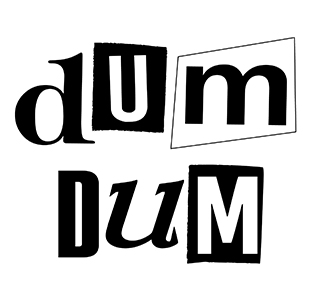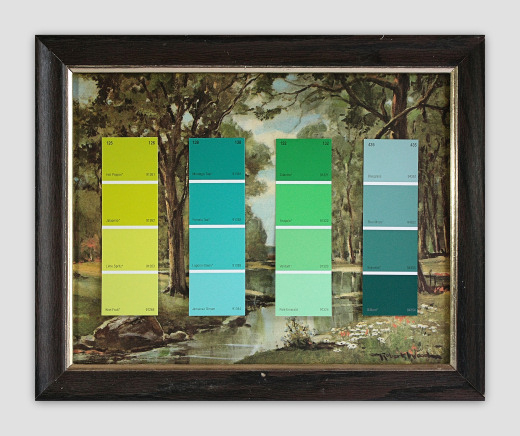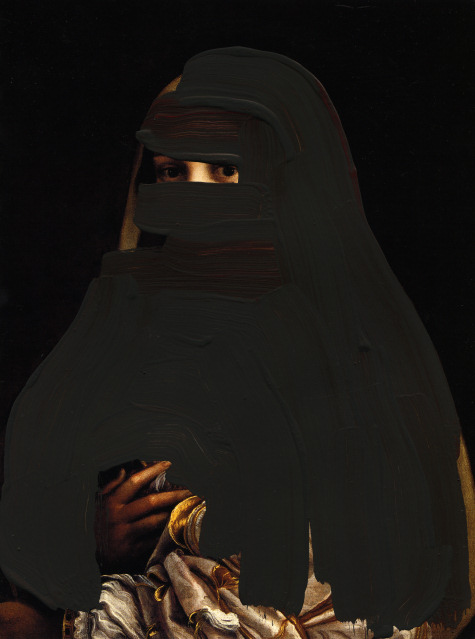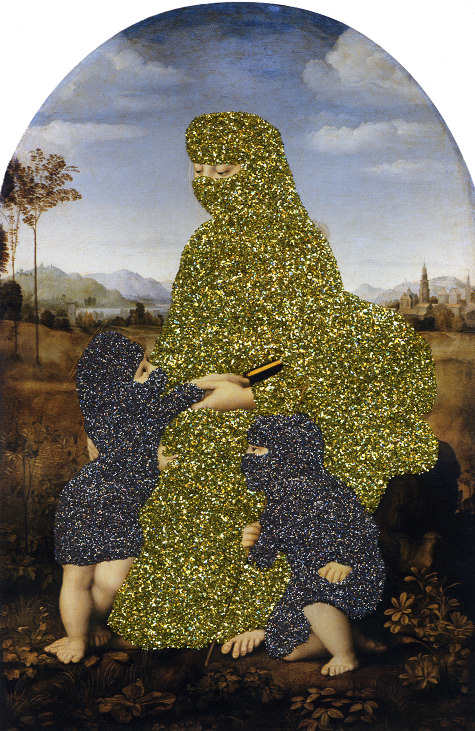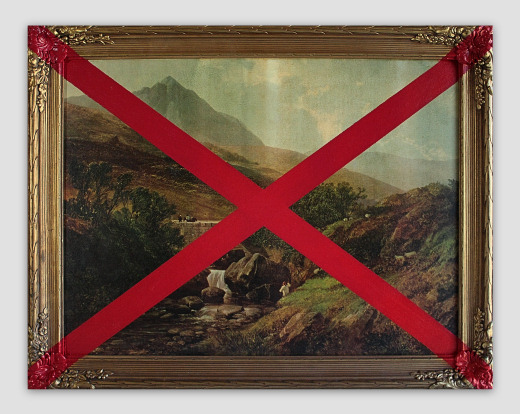Illinois artist Chad Wys explores notions of representation, objecthood, and deconstruction in his mixed-media work. We chat with Wys on a Sunday afternoon about his motivations, art, and inspiration–and how he’d title his work if it were a poem.
Jana FitzGerald 11:52am: Hi, Chad. Let’s get started. So, where are you in Illinois?
Chad Wys 11:53am: I’m born, raised, and live in Peoria–centrally located–a few hours south of Chicago.
JF: When did you start making art?
CW 11:54am: I’ve always been creative. I drew pictures before I knew how to read. But I’ve always been a bit of bookworm–more interested in art history than labeling myself an artist. It has really been within the last 4 years or so that I’ve really allowed myself to “become an artist” as it were.
JF 11:55am: From a referential or art historical context, who (or what) has informed your perspective?
CW: Well, a great deal of contemporary art informs what I do. I have just wrapped my post-grad degree in Visual Culture (or, what I would call a more updated version of Art History), and a large part of my study involved postmodern theory. Most contemporary art deals with postmodern issues–so learning how artists think has helped me understand them and also understand myself…both as an art critic or art historian and as an artist. I’ve always had an intense love of the 19th century–which is why I refer to Victorian and romantic portraiture so often. So, in summation, I have studied both aesthetics and theory from different eras of art history, and doing so has influenced me in the choices I make as an artist; e.g. the concepts I tackle (largely postmodern ones), and the images and object I appropriate (largely antique ones).
JF 12:04pm: I’ve noticed the reference to Victorian and romantic portraiture. What’s particularly interesting is the way that you take your understanding and re-contextualize it, using subtraction, deletion–maybe it’s even negation?
CW 12:10pm: Yes, I often use the term “deleted” in titling my work, and that is very much the same thing as negating various aspects of the images/object I appropriate. I think a main problem we face today is alienation–this is certainly a huge concept in the study of cultural theory today (even despite the illusion of “connectedness” the Internet and its social networks provide). So, I’ve often felt the urge to imagine alienation and identity struggle in the act of 1) appropriating familiar motifs and images, and 2) cropping, deleting, or obstructing various aspects of familiar-seeming imagery (e.g. a traditional Victorian portrait)–all in an effort to make the viewer feel some sense of conflict in what they literally see and in how they emotional decipher what I show them.
CW 12:11pm: So, cropping/deleting/editing are major aspects of my artistic process. “Truth” is never fully there anyway, so why not require the viewer to “finish” the work in their own mind? That’s far more truthful than a highly representational portrait.
JF 12:13pm: Right. And on the web, there’s certainly tremendous visual references available to viewers…which, perhaps plays into the idea of illusion of connectedness you mention.
CW 12:14pm: Oh yes. Images are powerful weapons–I mean tools–that, like never before, penetrate our lives.
JF 12:15pm: Absolutely. And they are increasingly available. I’m glad you brought up the idea about “alienation.” Your works like “Raphael in Black,” or “Portrait of a Woman with Deletions,” and even the glitter-tinged “Extasy” suggest a sense of distance, alienation. Can you talk briefly about what you choose to show to the viewer?
CW 12:22pm: At the very core of what I do is an investigation of aesthetics. This goes beyond merely ideals of beauty and attractiveness, into the realm of what feels comfortable to the viewer and what becomes traditional practice in art making. I love juxtaposition. I love hybrid. I revel in conflating things that shouldn’t be conflated. So beyond the deep conceptual problems I address with the gestures I make and the images I re-contextualize, there is a conscious and literal desire to manipulate and destroy — or to conflate art historical motifs together in one place where they “shouldn’t” belong. When I put organically-shaped pools of glitter over the Virgin Mary, I am conflating minimalist forms and academic realism. Two motifs that don’t make natural bedfellows. This requires the viewer to renegotiate an understand of what is visual expected and what has traditionally been “allowed.”
JF 12:24pm: Definitely–you’re inviting, maybe even forcing, the viewer to reconsider their understanding. It seems like you’re also inviting the viewer to question the notion of objecthood.
CW 12:31pm: Oh yes. Objects are important components of our everyday life. We collect. We amass. We often show ourselves how far we’ve come based on what we build up around us. My academic study of art history also gives me the desire to critique the institution of art itself. How silly a painting is if it does no more than decorate one’s lavish house or elevate one’s status. Despite knowing this, something inside me loves the idea of art as decoration and as a status symbol. I love the idea of art as an object to be fetishized and purchased; to be collected and cataloged. But I feel as though I should be very ashamed of these feelings, largely because I understand a deeper use for art in our lives. I understand that art has the unique and enormous power to make us question our own existence and how we contribute to the world at large. I often juxtapose these conflicting feelings (the desire for art objects as status and the idea for art objects as artifacts and meaningful beacons). I love that art is an object to some and a meaningful poem to others.
JF 12:33pm: You’re right to mention that dichotomy of art as object or poem–although I’d say it’s even more varied.
CW 12:34pm: Yes, not black or white, but shades of gray. I agree.
JF: “Shades of Gray”
CW 12:35pm: Yes, I like that title: “Shade of Gray”
JF 12:36pm: It seems like an apt title for the meaningful poem of your work.
CW 12:37pm: Ah yes, very nice.
JF 12:38pm: I like it. Catchy and apropos. Anyway, thanks for your time.
CW 12:39pm: Thanks for the interest.
JF: Thanks for being interesting. Bye!
